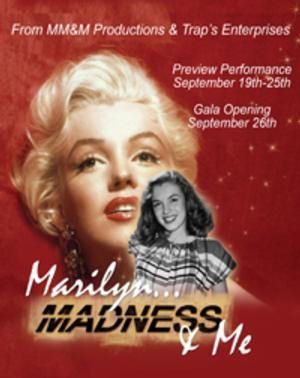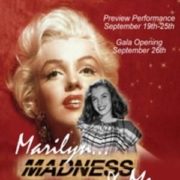MARILYN…MADNESS & ME
Marilyn…Madness & Me:
An American Classic Premieres
at the El Portal Theatre in North Hollywood
October 20, 2013
 Who Killed Norma Jean is the title of a song by Norman Rosten and Pete Seeger, who saw Rosten’s poem in Life Magazine in 1963 and set it to music. It goes through a dark list of those who had used her in life and now stood to profit from her death—her agents, her fans, the press and the men who exploited her desperate need to be loved. Like Bob Dylan’s scorching anti-boxing protest song Who Killed Davy Moore it shows that there is enough blame to go around. But neither song singles any one out to hold accountable.
Who Killed Norma Jean is the title of a song by Norman Rosten and Pete Seeger, who saw Rosten’s poem in Life Magazine in 1963 and set it to music. It goes through a dark list of those who had used her in life and now stood to profit from her death—her agents, her fans, the press and the men who exploited her desperate need to be loved. Like Bob Dylan’s scorching anti-boxing protest song Who Killed Davy Moore it shows that there is enough blame to go around. But neither song singles any one out to hold accountable.
Who really killed Norma Jean? A new play has a theory. And however incredible it may seem, I now know how the audience felt on the night of February 10, 1949 at the Morosco Theatre on Broadway for the premiere of Arthur Miller’s Death of a Salesman, as they watched a classic being born. I got to see the Sunday matinee closing performance of the world premiere of Marilyn…Madness and Me by Frank V. Furino from an original concept by Didier Bloch and brilliantly directed by Joe Leonardo at the El Portal Theatre in North Hollywood.
The person driven mad in the play is not, as you might think, Arthur Miller, though he does of course play a prominent part—Monroe’s third husband. Nor is it Joe Dimaggio—her second husband—who sent fresh roses to her crypt every week until he died, and was there for her long after their marriage ended. The mad man is the nondescript narrator, who introduces himself as Tim—starring Adam Meyer—Ms. Monroe’s limousine driver.
One is somewhat constrained in reviewing the play because the voice over announcer at the beginning warns the audience not to reveal the plot for those who haven’t seen it, a memorable line first used in Billy Wilder’s film opening of Agatha Christie’s Witness for the Prosecution. But now that the play’s premiere has closed, perhaps one may bend the rules a bit. Tim pleads with the audience not to judge him until we have heard “the whole story,” and a whopper it is. Unless you are familiar with the highlights and lowlifes of modern American history—in which case this play noir is not as farfetched as it seems.
It opens in 1961, with the election of President John F. Kennedy. Act 1 ends with the assassination of the president, but that is entirely incidental to the story—really just a clever framing device. (Spoiler alert: stop reading here if you do plan to see the play!)
Or is it? Well, what are the odds that Marilyn Monroe’s limousine driver would happen to have had a significant encounter with the president’s assassin, whom he met under the name of “Ozzie” to whom he sold his restored Corvette? Hint: it wasn’t Ozzie Nelson, or The Wizard of Oz. And what are the odds he would have come down in his asking price when he learned Ozzie needed $1,000 to buy a long-range rifle, after confiding in him he needed the car to drive to Dallas, where he had a date with the president.
And what has all this to do with Marilyn Monroe (who was born Norma Jeane Mortenson June 1, 1926)? Oh, you hadn’t heard; Marilyn knew the president, as in the biblical sense.
The play takes off from the night Marilyn died, in Los Angeles, on August 5, 1962 from an overdose of barbiturates. At least that’s the official, coroner’s version. But Tim has some inside knowledge of that fateful night, because he got there before the coroner did; and came away with her personal diary, loosely bound in red leather. The play is a recounting of significant events Marilyn reports in her diary, both told by Tim, on stage, and recounted by Marilyn herself, off-stage, behind a long black veil curtain that reveals just enough of her—starring Alison Janes—in the uncannily hypnotic dual role of Marilyn and Norma Jean, reading from the same diary.
Hint: it’s not the Diary of Anne Frank; but one might add that, in a psychological sense, she is in hiding; that is, Norma Jean is in hiding as Marilyn Monroe. Tim is the only one in the play to penetrate that veil and make a real connection with the tortured girl behind the public legend. He does so during a trip they take to Catalina Island, which leaves him with a souvenir cap and a world of hurt that eventually drives him, as the title says, mad.
On that ill-fated trip they stay in a hotel together, and at her request, in the same room, indeed, the same bed. But they don’t do what you might imagine from her over-embellished reputation. They exchange only one chaste, but nonetheless deeply romantic, kiss. And like Rodin’s The Kiss, it lasts a lifetime. Tim exercises the restraint needed to keep their relationship from becoming sexual, in a profoundly honorable quest to show her that all men aren’t alike and that his love is real. He is all too well aware of the men who have used her and abused her for what they could take and he is resolved not to become one of them.
Unfortunately, he is incapable of grasping just how complete her captivity is by the world of fame she inhabits. She both recognizes he is different and has no ability to retreat from the enticements her own fame exposes her to—including a fling with the most powerful man in the free world. In the end that is her doom, and it not only dooms her, but the one man in her life who is not trying to exploit her, the narrator Tim. Like “the young man in the 22nd row” of Elton John and Bernie Taupin’s Candle In the Wind, Tim’s love is pure. He never sees her in the nude until the fateful encounter with her dead body, open pill bottles on the table, and her diary beside her.
When Act 2 opens five years later, in mid-1968, we see a very different Tim; he is still an alcoholic, but instead of drinking a series of Budweiser bottled beers he is now drinking straight whiskey out of the bottle. He is a returned Vietnam vet who has lost his right arm and won a Purple Heart from his battle wound, which he dismisses not as heroism but his own failure in that he never intended to come back from the war. In one of the plays many memorable lines he asks us if we had heard of “suicide by cop;” then confides that he fully intended to commit “suicide by war.” The Viet Cong stifled his plans by only taking his arm, “and giving me a ticket home.” As he continues his drunk-a-log (for those familiar with AA lingo) we learn that he could no longer drive a limousine because he served time for—what else—drunk driving and his company wouldn’t take him back. So he winds up taking the only job he can find, working in a stable in Santa Anita on the one condition that he wouldn’t have to shovel manure.
And guess who he meets? A strange character named “Hoss,” who turns out to be a Palestinian fanatic who has conceived an intense hatred for the slain president’s brother, because he is campaigning for president on a platform that includes sending arms to Israel. It turns out that “Hoss” and Tim have something in common: Tim also hates Bobby Kennedy, but for his own very personal reason, which he reveals in another passage from Marilyn’s diary. Bobby also saw Marilyn during her very last days before her death. And, according to Tim, it was he who pushed Marilyn, or Norma Jean, over the edge. What could a man like Tim do about revenge against the man he holds responsible above all others for her descent into despondency and suicide? Not much, not until he meets this “Hoss” who finally reveals his true name to Tim.
You won’t hear it from me; suffice to say that his initials are “S.S.” and his first and last names are identical.
Tim lets “Hoss” in on another little secret: Bobby Kennedy’s itinerary in the last month of the campaign, culminating in his arrival at the Ambassador Hotel on the night of his coronation as the Democratic Nominee for President of the United States. Tim pours gasoline on the fire raging in “Hoss’s” tormented mind.
The historic El Portal Theatre in North Hollywood was the perfect venue to host the premiere run of Marilyn…Madness & Me. Norma Jean Baker frequented the theatre as an aspiring young actress in the city where she was raised as an unwanted child who was raised in LA’s orphanages. She wasn’t even sure who her father was. Today they have renamed it The Marilyn Monroe Forum in her honor, and the lobby is a wonderful photo gallery of some of her most captivating shots, including the extraordinary picture of her working out with barbells. The determination on her face captures how seriously she saw her task—to transcend her barren beginnings and make of her life something meaningful out of her own sheer will and talent.
Monroe’s story is the Hollywood legend writ large, and even in the reflected memories of one obsessed suitor who had the misfortune to fall hopelessly in love with her it shines in full splendor. Bravo to these two superlative actors, Adam Meyer and Alison Janes, who brought it to life. And bravo to the El Portal Theatre—nee the Marilyn Monroe Forum—who provided the perfect setting.
And one personal thank you; to the theatre manager: I went alone on Sunday for the final matinee and they honored my unused Friday evening tickets, disregarding their own clearly stated policy that there were no refunds or exchanges allowed.
Finally, is this a tale told by an idiot, full of sound and fury, signifying nothing? Or is it a radical revisionist history of the 1960s, with three iconic legacies hanging in the balance?
What are the odds that one inconsequential limousine driver could so have changed the history of our times? I’d say slim to none. But what are the odds you will exit this play believing that—in some strange twist of fate—justice has been done? Don’t bet against it.
Goodbye Norma Jean.
Ross Altman will host In Memoriam JFK at The Talking Stick on the 50th anniversary of November 22, 7:00 to 10:00pm; 1411 Lincoln Blvd, Venice, CA 90291; 310-450-6052.
Ross Altman may be reached at greygoosemusic@aol.com













